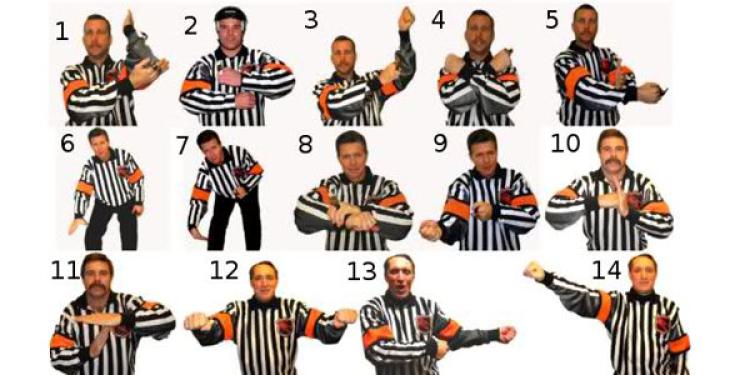The Basic Rules of Ice Hockey – Penalties in Hockey (PART I)
Posted: April 19, 2016
Updated: April 19, 2016

Penalties in hockey are an important part of the sport, so it is vital to find out how penalties in hockey work in order to understand the sport better.
The player in the box naturally cannot participate in the game, and in most cases he cannot be replaced by another player on ice. His team therefore becomes short handed and usually deploys its “penalty killing” unit – a certain group of players who are the best in defending these situations.
The other team is in power play and its objective is usually to line up in power play formation in the offensive zone in order to exploit the advantage of being superior in numbers and to score a goal. Many penalties in hockey end with a goal being scored by the team in power play.
There are delayed penalties in hockey too. In this case the referee raises his hand to signal that he will enforce the penalty only when a player from the offending team touches the puck. Therefore the goaltender is usually substituted for an extra forward by the favored team to start power play situation immediately, since the opponent cannot touch the puck and therefore cannot score a goal.
There are extreme and funny situations when the opposing team scores an own goal coincidentally – this is the only way a goal can be scored by the penalized team during a delayed penalty.
This situation I especially funny, since the goal is awarded for the player who last touched the puck from the scoring team and this can be way before the puck made its way to the empty net…
They can be very helpful for anyone who bet on sports in Canada and worldwide. They can help determining the outcome of a certain game when preparing for a pre-game wager, or certain situations when placing in-game hockey betting wagers. For example a team with high Power Play Percentage against a team with low Penalty Kill Percentage will likely score a goal from power play and vice versa.
In the next and final part of our ice hockey rules guide we will assess the certain types of penalties in ice hockey to complete this short training of players who would like to wager on NHL and other ice hockey games at online sportsbooks in the EU and worldwide.
The Basic Rules of Ice Hockey
The Basic Rules of Ice Hockey – Offside and Icing
The Basic Rules of Ice Hockey – Checking in Ice Hockey
The Basic Rules of Ice Hockey – Officials in Hockey
In our guide to penalties in hockey:To further improve your hockey betting skills, you have to learn how penalties in hockey work. This knowledge is vital for anyone who is involved with ice hockey internet betting as Penalties in Minutes (PIM), power play and penalty kill stats can be decisive factors in a hockey game. So, this ice hockey rules guide is equally useful for pre-game betting and in-game betting, as well as for understanding the sport better in general.
- What is a short handed team?
- Penalty killing in hockey
- How does power play work?
- What is a delayed penalty?
- How do penalty stats help you when betting?
Penalty box, short handed team, penalty killing
Penalties in hockey usually mean penalty minutes for a player who violated the rules. The offending player has to spend the penalty minutes in the penalty box. He is released from the penalty box by the penalty timekeeper. Penalties in hockey are usually imposed by the referee, sometimes by a lineman.The player in the box naturally cannot participate in the game, and in most cases he cannot be replaced by another player on ice. His team therefore becomes short handed and usually deploys its “penalty killing” unit – a certain group of players who are the best in defending these situations.
Power play, delayed penalty
The other team is in power play and its objective is usually to line up in power play formation in the offensive zone in order to exploit the advantage of being superior in numbers and to score a goal. Many penalties in hockey end with a goal being scored by the team in power play.
There are delayed penalties in hockey too. In this case the referee raises his hand to signal that he will enforce the penalty only when a player from the offending team touches the puck. Therefore the goaltender is usually substituted for an extra forward by the favored team to start power play situation immediately, since the opponent cannot touch the puck and therefore cannot score a goal.
There are extreme and funny situations when the opposing team scores an own goal coincidentally – this is the only way a goal can be scored by the penalized team during a delayed penalty.
This situation I especially funny, since the goal is awarded for the player who last touched the puck from the scoring team and this can be way before the puck made its way to the empty net…
The importance of penalties in hockey
Power Play Percentage is the ratio of the power play goals per all power play situations. It shows how effectively a team can convert power plays to goals. Penalty Kill Percentage shows how effectively a team can avert conceding goals when playing short handed. Power Play Percentage and Penalty Kill Percentage are very important statistics in ice hockey.They can be very helpful for anyone who bet on sports in Canada and worldwide. They can help determining the outcome of a certain game when preparing for a pre-game wager, or certain situations when placing in-game hockey betting wagers. For example a team with high Power Play Percentage against a team with low Penalty Kill Percentage will likely score a goal from power play and vice versa.
In the next and final part of our ice hockey rules guide we will assess the certain types of penalties in ice hockey to complete this short training of players who would like to wager on NHL and other ice hockey games at online sportsbooks in the EU and worldwide.
The Basic Rules of Ice Hockey
The Basic Rules of Ice Hockey – Offside and Icing
The Basic Rules of Ice Hockey – Checking in Ice Hockey
The Basic Rules of Ice Hockey – Officials in Hockey
Related content
Subscribe
0 Comments












